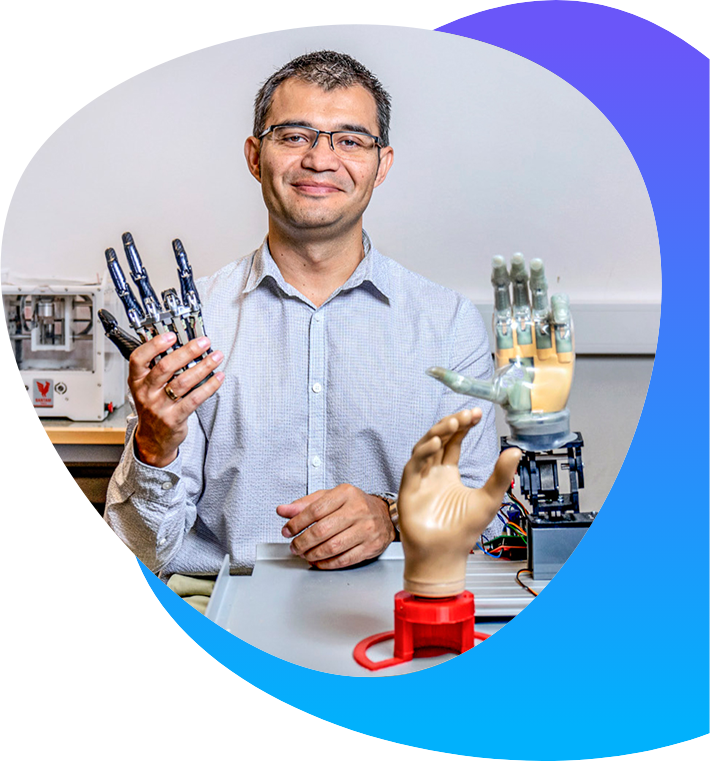Bionic limbs: Restoring quality of life after limb loss
Watch a 2 minute video on our bionic limb research
The challenges of current limb prosthetics
Limb loss reduces a person’s ability to perform everyday tasks and has considerable impact on quality of life.
In 2017, 57.7 million people were living with limb amputation due to traumatic causes worldwide [1].
Conventional approaches to attaching prosthetics to the human body result in artificial limbs that can cause pain and discomfort, and are difficult for a patient to control.
Prosthetic limbs currently available doesn’t provide the wearer with sensory (eg tactile) feedback – the ability to ‘feel’ what the bionic limb is touching.
As a result, many patients choose to limit the time they wear their prosthesis, or to not wear it at all.
Bionic technology solutions
Our research is focused on creating bionic limbs which are highly integrated with the human body, restoring the functionality of a limb lost through amputation or congenital limb malformation.
The team, led by Professor Max Ortiz Catalán, is using surgical and engineering techniques to connect individuals’ prosthesis with their nervous system, resulting in bionic limbs with more reliability and dexterity than current options.
By inserting a titanium implant into a patient’s bone (a technique called osseointegration), bone cells are allowed to grow tightly around the implant – creating a strong and comfortable mechanical connection to a prosthesis.
The electronic control system of the prosthesis is then connected to the patient’s nerves and muscles, creating a neuromusculoskeletal human-machine interface. This interface supports brain signals to travel through the nerves and muscles safely and reliably to the bionic limb, giving the patient movement control and sensory awareness.
As an example, this means that a patient can control a robotic hand as they would move their own biological hand – every finger on it.
Sensors in the robotic hand also make for a more intuitive experience, enabling the patient to detect contact with the prosthesis, know what position the hand is in, and the amount of force applied to objects during grasping. This information is sent back to the patient’s brain by electrically stimulating the nerves that used to be connected to their missing hand.
Integrating the bionic limb in this way enables the prosthesis to be used in the patient’s daily life and not just in a controlled research environment.
Watch Professor Max Ortiz Catalán’s WIRED feature
Next steps for our research
We are currently developing new surgical procedures, neural interfaces, and artificial intelligence algorithms to further increase the capability of the bionic limb and the richness of sensory feedback. Crucial for clinical implementation, we are also developing strategies to eliminate the risk of infections and other complication with the osseointegrated interface.
Key publications
- Ortiz-Catalan M., Mastinu E., Sassu P., Aszmann O., and Brånemark R., Neuromusculoskeletal arm prostheses, New England Journal of Medicine, 2020, 382(18):1732-1738
- Middleton A., and Ortiz-Catalan M., Neuromusculoskeletal limb prostheses: personal and social implications of living with an intimately integrated bionic arm, Frontiers in Neurorobotics, 2020, 14:3.
- Ortiz-Catalan M., Håkansson B., and Brånemark R., Osseointegrated human-machine gateway for long-term stable sensory feedback and motor control of artificial limbs, Science Translational Medicine, 2014, 257re6.
- Ortiz-Catalan M., Zbinden J., Millenaar J., D’Accolti D., Controzzi M., Clemente F., Cappello L., Earley E., Mastinu E., Kolankowska J., Munoz-Novoa M., Jönsson S., Cipriani C., Sassu P., and Brånemark R., A highly integrated bionic hand with neural control and feedback for use in daily life, Science Robotics, 8(11):eadf7360.
- Zbinden J., Sassu P., Mastinu E., Earley E., Munoz-Novoa M., Brånemark R., and Ortiz-Catalan M., Improved control of a prosthetic limb by surgically creating electro-neuromuscular constructs with implanted electrodes, Science Translational Medicine, 2023, 15 (704):eabq3665
References
[1] C. L. McDonald, S. Westcott-McCoy, M. R. Weaver, J. Haagsma, and D. Kartin, “Global prevalence of traumatic non-fatal limb amputation,” Prosthetics Orthot. Int., vol. 45, no. 2, pp. 105–114, Apr. 2021, doi: 10.1177/0309364620972258.
Medical Disclaimer
This article contains general information relating to a medical condition. Such information is provided for informational purposes only and does not replace medical advice given by your healthcare professional.
